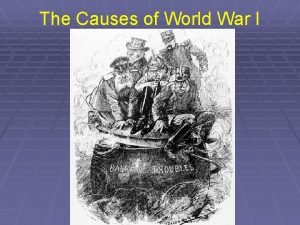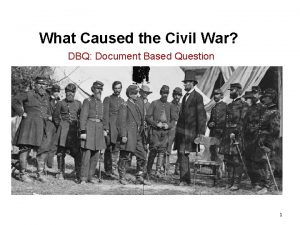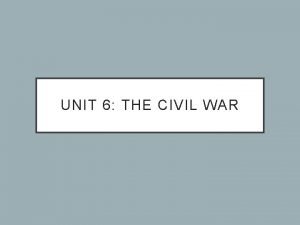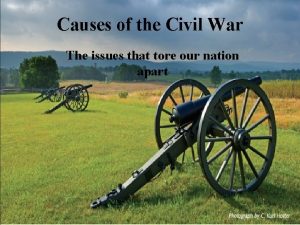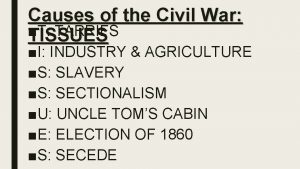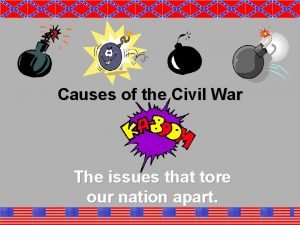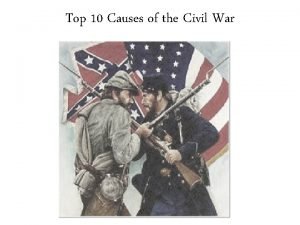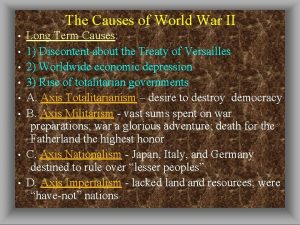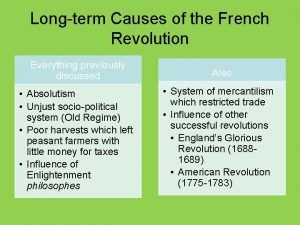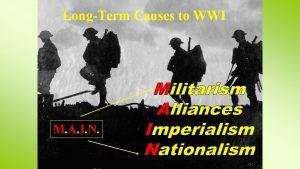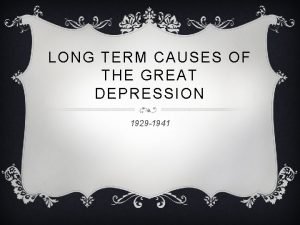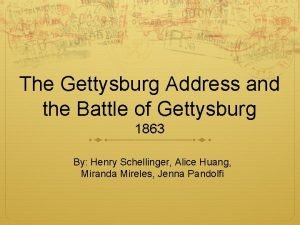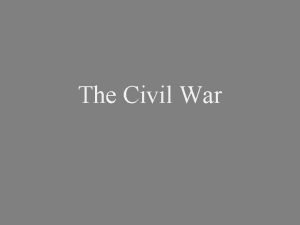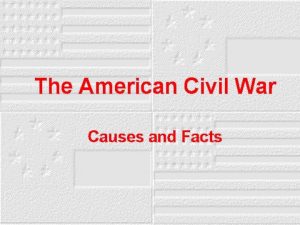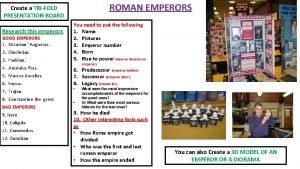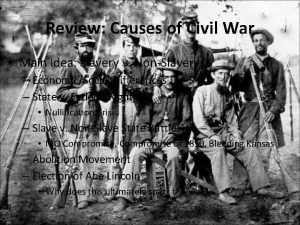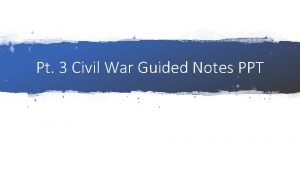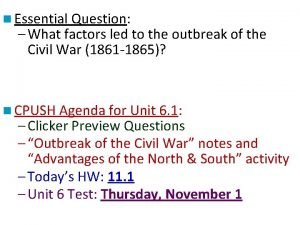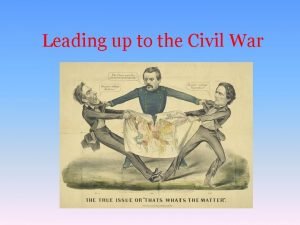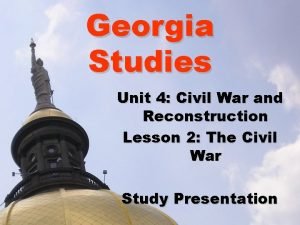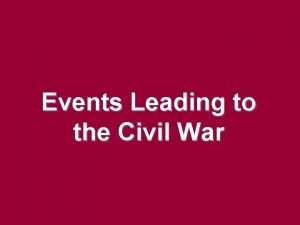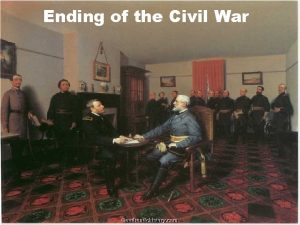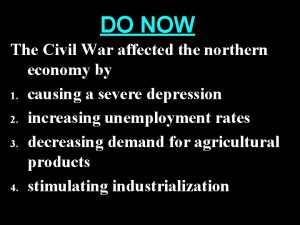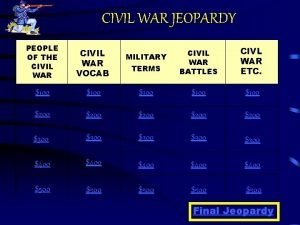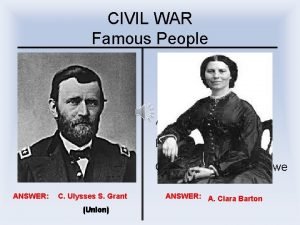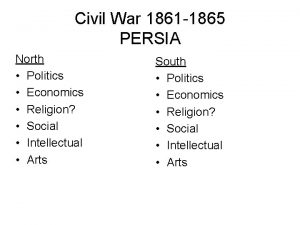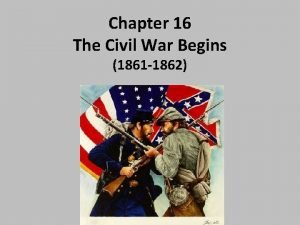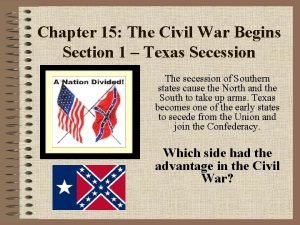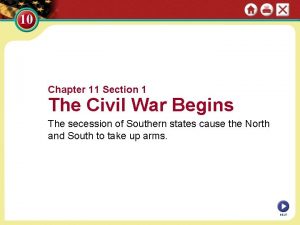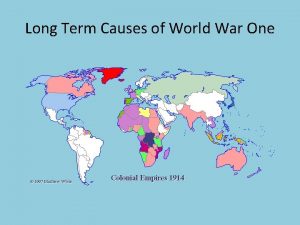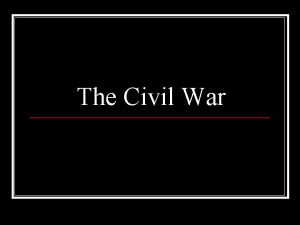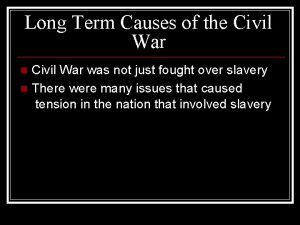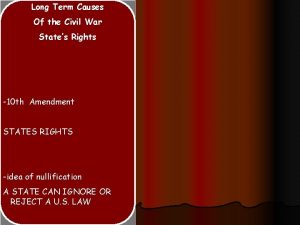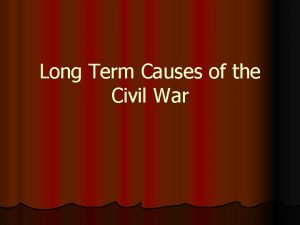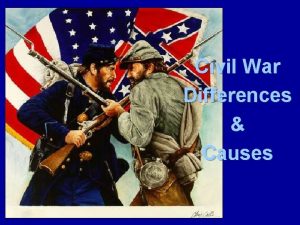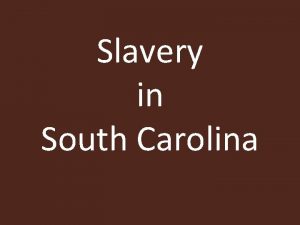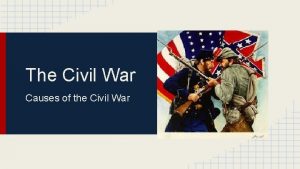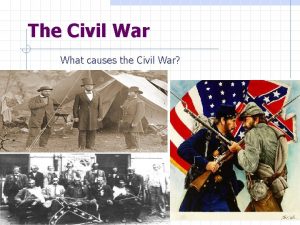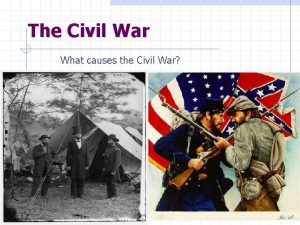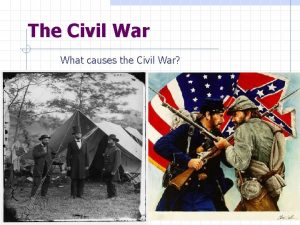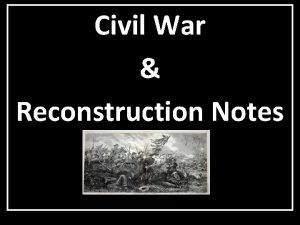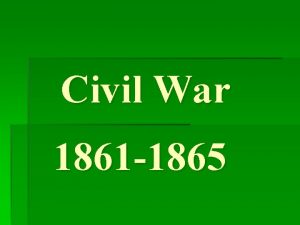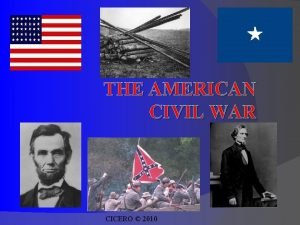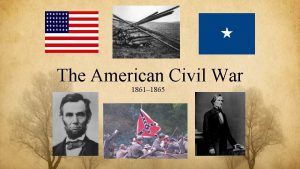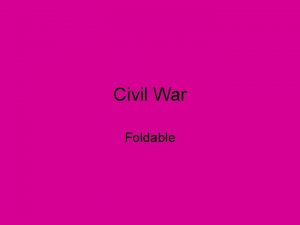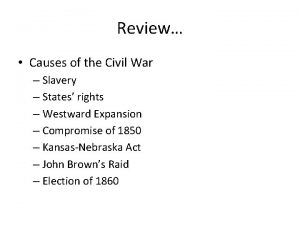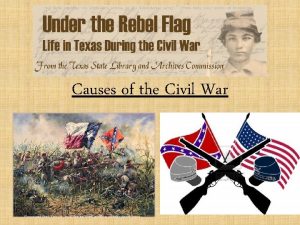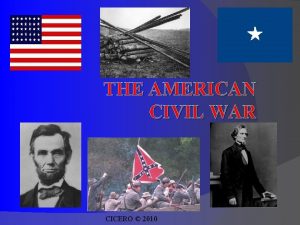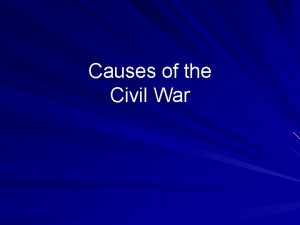Long Term Causes of the Civil War Slavery



















































- Slides: 51

Long Term Causes of the Civil War Slavery and Western Expansion

Impact of War w/Mexico Heightened sectional tensions Opened new lands to the issue of slavery CURRENT LAW – MISSOURI COMPROMISE Southerners wanted new laws to help return runaway slaves Polk – believed the expansion of slavery a null and void issue – dry climate of southwest not suitable for growing cash crops Ultimately – he believes slavery will destroy the Democrats & Union

Wilmot Proviso Originally – Appropriations bill – started in the House --- amendment --- no slavery or involuntary servitude in land acquired through war Passed in the House – Northern Rejected --- Senate – balanced Calhoun Resolution -- States own the United States Fed Had no right to make laws in the states or territories

Popular Sovereignty Allowing citizens to decide for themselves the issue of slavery --- idea of Michigan Senator Lewis Cass Free Soilers – combination of two groups Northern “Conscience” Whigs & Northern Democrats Whigs divided – “Cotton” vs “Conscience” Democrats Divided – Northern vs Southern

Election of 1848 Cotton Whigs & Southern Dem – nominate Zachary Taylor Free Soilers – Nominate – Martin Van Buren Democrats – Lewis Cass Zachary Taylor wins the Election

California Slavery brought to the forefront early on in Taylor’s Presidency 1849 – California Gold Rush – 80, 000 people went to California – apply for statehood – (popular sovereignty) 1849 – California applied as a Free State

Great Debate (Southern Position) 1. slaveholding states would be a minority in the senate 2. northerners would dominate national politics 3. threat of secession – ** need for Compromise --- Henry Clay

Other Issues dealing w/ slavery in Congress Texas / NM – border --- extend or stop slavery District of Columbia – slavery in the nation’s capital Slave trade within the US -- regulate or not

Clay’s Compromise Offered as a package plan Allow Calif – free state/ organize rest of Mexican cession w/out any restrictions (popular sovereignty) settles border disputes bt/ Texas & NM – favored NM – gov’t acquired Texas’ debts. Outlawed slave trade in D. C. – did not outlaw slavery itself Congress would not interfere in domestic slave trade --- enforce a Stiffer Fugitive Slave Act

Results of Compromise 1. did not pass originally – because it was offered as a package deal Makeup of Congress Changes Calhoun Dies of TB Taylor who opposed Clay’s Compromise – suddenly dies VP – Millard Filmore now President supports Henry Clay Webster – states right activist – Sect. of State Clay – leaves the Senate

Stephen Douglass – 33 yr old devises a plan – offer each idea individually – attain majority support – pass -Known as Compromise of 1850

Compromise of 1850

Fugitive Slave Act 1. all fugitives were not entitled to a trial by jury, despite the 6 th Amendment – 2. fugitives could not testify on their own behalf 3. A statement by the slaveowner describing the escapee was all that was needed to have a slave returned 4. Federal commissioners that enforced the law – granted $10 only $5 if they were let free 5. anyone convicted of helping a fugitive – $1, 000 fine 6. anyone could be compelled to help capture runaways – deputize on spot

Immediate Causes of the Civil War VIOLENCE & CRISIS

Harriet Beecher Stowe (1811 – 1896) -- So this is the lady who started the Civil War. Abraham Lincoln

Uncle Tom’s Cabin Written by Harrier Beecher Stowe came out (book form) 1852 – sold 300, 000 copies Presented African American as – real people suffering form dreadful circumstances – It depicted the harshness of the institution of slavery She was motivated to write this book by the Fugitive Slave Act of 1850 – part of 1850 Compromise

Uncle Tom’s Cabin 1852 § Sold 300, 000 copies in the first year. § 2 million in a decade!

Uncle Tom’s Cabin, 1852

Northern Resistance Frederick Douglass – Henry David Thoreau The Underground Railroad – well organized system of freeing slaves – transporting them from the south – north. Conductors Harriet Tubman Levi Coffin

Sectionalism over the Railroad Southern Position – if US creates new territories – they should be open to slavery – like the territories acquired by war – if this happens they will agree to railroad beginning in the North Stephen Douglass – knows that any attempt to repeal compromise – will divide the country

Bleeding Kansas Situation – Kansas was the first testing/ battling ground for new law “Bleeding Kansas” 1. March 1855 Kansas had enough to hold an election to establish territorial legislature David Atchinson Lecompton Constitution May 21, 1856 – Sack of Lawrence Pottawatamie Massacre Violence in the Senate – “Caning of Charles Sumner”

“Bleeding Kansas” Border “Ruffians” (pro-slavery Missourians)

Kansas-Nebraska Act, 1854

I. New Political Parties Emerge By the end of 1856, the nation’s political landscape had drastically changed Whigs – split over slavery Northern Conscience Whigs Southern Cotton Whigs Democrats – alive – yet scarred – split over slavery Northern Democrats Southern Democrats

II. Anti –Slavery Parties Form A. Liberty Party – formed in 1844 – platform to pursue the cause of abolition by passing new laws ( effected the election of 1844 bt Clay & Polk) Free Soil Party – opposed the extension of slavery into the territories Chose Martin Van Buren in 1848 – failed to win any of the electoral vote – won 10% of popular vote ** NOT ABOLITIONISTS – objected to ending slavery on economic grounds – did not want slavery to extend

1852 Presidential Election √ Franklin Pierce Democrat Gen. Winfield Scott Whig John Parker Hale Free Soil

1852 Election Results

John Brown: Madman, Hero or Martyr? Mural in the Kansas Capitol building by John Steuart Curry (20 c)

John Brown’s Raid on Harper’s Ferry, 1859

1859 John Brown had dedicated his life to freeing the slave – leading a rebellion – it was his calling – and he believed the time to be ripe. October 16, 1859 – led a band of men black/ white into Harper’s Ferry, Va. Wanted to seize the Federal Arsenal Distribute arms to slaves No rebellion occurred – slaves were scared 8 of Brown’s men killed Couple of Days later – Col. Robert E. Lee killed 2 more men and captured Brown and his surviving men Brown was hanged December 2, 1859

“The Crime Against Kansas” Sen. Charles Sumner (R-MA) Congr. Preston Brooks (D-SC)

Slavery & Secession

Lecompton Constitution A. Fall of 1857 – pro-slavery gov’t at Lecompton – wrote a constitution and applied for admission – (slave state) i. Kansas had 60, 000 plus in pop. – however it was 10 to 1 in favor of freesoliers -- ii. President Buchannon endorsed the Lecompton Constitution iii. Stephen Douglas – outraged said it was against the Kansas/ Nebraska Act – allowed for popular sovereignty

Douglas persuaded Congress to authorize another referendum on the Lecompton Constitution --voters rejected the Constitution – Kansas will enter as a Free State – Douglas a hero

Lincoln/ Douglas Debates 1858 race for Senate in the state of Illinois featured 2 term incumbent Stephen Douglas & former Whig Congressman now Republican Abraham Lincoln. ** to gain recognition Lincoln challenged Douglas to a series of 7 open air debates

Douglas “Little Giant” Stocky and energetic Spoke with his hands, dramatically, pounding on the podium with fists, pacing dressed in sharp clothes, used impressive language Beliefs – believed that popular sovereignty was correct method in handling slavery

Stephen Douglas & the Freeport Doctrine Popular Sovereignty?

Lincoln 6’ 4’’ tall, gangly , wore a stove piped hat, dressed in plain, rumpled clothes, former lawyer, politician, spoke in plain language Beliefs – believed slavery to be immoral/ “labor system based on greed” he was opposed to the spread of slavery – didn’t expect southerners to give up slavery

2 nd Debate – Freeport, Illinois Freeport Doctrine – L – “Could the settlers of a territory vote to exclude slavery before that territory became a state? ” (Dredd Scott) D – Slavery cannot exist a day or an hour anywhere, unless it is supported by local police regulations. ” Douglas will win the Senate, but now some Republicans view Lincoln as an excellent candidate for Presidency.

The Lincoln-Douglas (Illinois Senate)Debates, 1858 A House divided against itself, cannot stand.

Election of 1860 Northern Democrats – Stephen Douglas Southern Democrats – John C. Breckenridge KK and Whigs – John Bell Republicans – Abraham Lincoln won the Election – Sectional Support 1. 9 million – 2. 8 million votes 180 – 123 in the E. C. Never appeared on a ballot in most of the slave states

√ Abraham Lincoln Republican Stephen A. Douglas Northern Democrat 1860 Presidential Election John Bell Constitutional Union John C. Breckinridge Southern Democrat

Republican Party Platform in 1860 ß Non-extension of slavery [for the Free-Soilers. ß Protective tariff [for the No. Industrialists]. ß No abridgment of rights for immigrants [a disappointment for the “Know. Nothings”]. ß Government aid to build a Pacific RR [for the Northwest]. ß Internal improvements [for the West] at federal expense. ß Free homesteads for the public domain [for farmers].

1860 Election: 3 “Outs” & 1 ”Run!”

Secession!: SC Dec. 20, 1860

1860 Election: A Nation Coming Apart? !

1860 Election Results

Crittenden Compromise: A Last Ditch Appeal to Sanity Senator John J. Crittenden (Know-Nothing-KY)

Southern Secession The south had decided that they had lost their voice in national politics – nothing left to do but secede Dec. 20, 1860 SC leads the way Sherman’s Reaction Mississippi 2/9/61 & Florida 2/10/61 – Alabama, Georgia, Louisiana, Texas

Shaping of Confederacy Feb. 4, 1861 delegated from secessionist states met in Montgomery Alabama where they formed the CSA – Constitution President – Jefferson Davis VP –Alexander Stephens

Fort Sumter: April 12, 1861
 Main causes of world war 1
Main causes of world war 1 Causes of the civil war dbq
Causes of the civil war dbq What were some causes of the civil war
What were some causes of the civil war Myjeopardy
Myjeopardy What were the 4 main causes of the civil war
What were the 4 main causes of the civil war Tissues causes of civil war
Tissues causes of civil war What are the 3 main causes of the civil war
What are the 3 main causes of the civil war Causes of the civil war
Causes of the civil war Causes of the english civil war
Causes of the english civil war Why was the civil war the first modern war
Why was the civil war the first modern war Toward civil war lesson 3 secession and war
Toward civil war lesson 3 secession and war Ww2 long term causes
Ww2 long term causes American revolution causes and effects
American revolution causes and effects Main long term & immediate causes of wwi
Main long term & immediate causes of wwi What were the long term causes of the great depression
What were the long term causes of the great depression Long term plan and short term plan
Long term plan and short term plan Long term memory vs short term memory
Long term memory vs short term memory Short term and long term human resource planning
Short term and long term human resource planning Difference between long term and short term liabilities
Difference between long term and short term liabilities Long term liabilities
Long term liabilities Long term goal
Long term goal Short term finance planning
Short term finance planning Long and short
Long and short Once upon a time there was a little man
Once upon a time there was a little man Từ ngữ thể hiện lòng nhân hậu
Từ ngữ thể hiện lòng nhân hậu Civil rights and civil liberties webquest
Civil rights and civil liberties webquest Proximate causes vs ultimate causes
Proximate causes vs ultimate causes Altruistic acts examples
Altruistic acts examples Civil war map activity
Civil war map activity Gettysburg battle
Gettysburg battle English civil war timeline
English civil war timeline What led to civil war
What led to civil war Civil war facts
Civil war facts Civil war staar questions
Civil war staar questions Civil war trifold
Civil war trifold Conclusion of the civil war
Conclusion of the civil war Ppt
Ppt Civil war advantages and disadvantages chart
Civil war advantages and disadvantages chart What led to the civil war
What led to the civil war Civil war trading cards project
Civil war trading cards project Unit 4: civil war and reconstruction
Unit 4: civil war and reconstruction What events led to the civil war
What events led to the civil war Civil war map sherman's march to the sea
Civil war map sherman's march to the sea The civil war affected the northern economy by
The civil war affected the northern economy by Civil war and reconstruction study guide
Civil war and reconstruction study guide What is gettysburg
What is gettysburg Famous people of the civil war
Famous people of the civil war Civil war advantages and disadvantages chart
Civil war advantages and disadvantages chart Civil war resumes
Civil war resumes Chapter 16 the civil war begins worksheet answers
Chapter 16 the civil war begins worksheet answers States rights
States rights Chapter 11 section 1
Chapter 11 section 1
